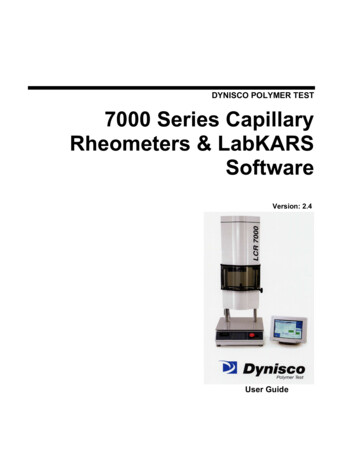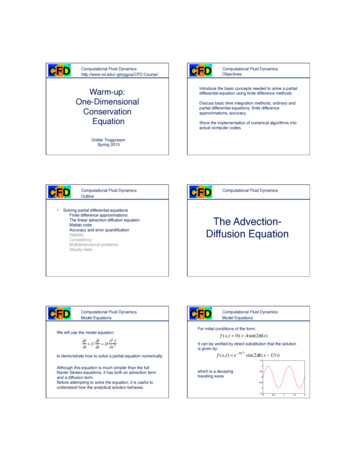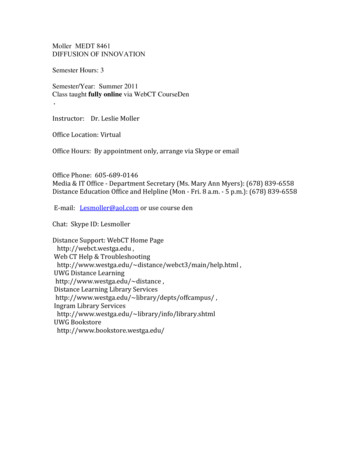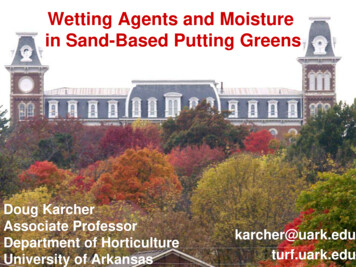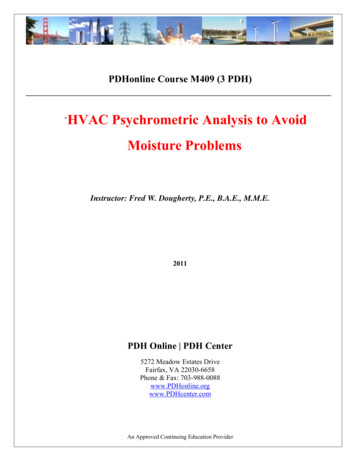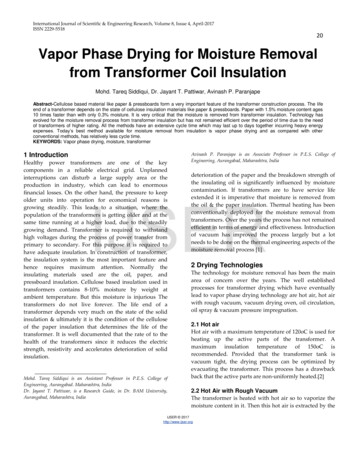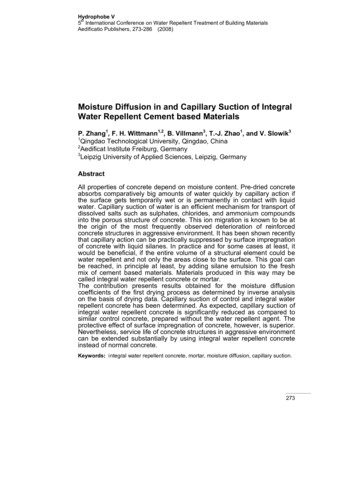
Transcription
Hydrophobe Vth5 International Conference on Water Repellent Treatment of Building MaterialsAedificatio Publishers, 273-286 (2008)Moisture Diffusion in and Capillary Suction of IntegralWater Repellent Cement based MaterialsP. Zhang1, F. H. Wittmann1,2, B. Villmann3, T.-J. Zhao1, and V. Slowik31Qingdao Technological University, Qingdao, China2Aedificat Institute Freiburg, Germany3Leipzig University of Applied Sciences, Leipzig, GermanyAbstractAll properties of concrete depend on moisture content. Pre-dried concreteabsorbs comparatively big amounts of water quickly by capillary action ifthe surface gets temporarily wet or is permanently in contact with liquidwater. Capillary suction of water is an efficient mechanism for transport ofdissolved salts such as sulphates, chlorides, and ammonium compoundsinto the porous structure of concrete. This ion migration is known to be atthe origin of the most frequently observed deterioration of reinforcedconcrete structures in aggressive environment. It has been shown recentlythat capillary action can be practically suppressed by surface impregnationof concrete with liquid silanes. In practice and for some cases at least, itwould be beneficial, if the entire volume of a structural element could bewater repellent and not only the areas close to the surface. This goal canbe reached, in principle at least, by adding silane emulsion to the freshmix of cement based materials. Materials produced in this way may becalled integral water repellent concrete or mortar.The contribution presents results obtained for the moisture diffusioncoefficients of the first drying process as determined by inverse analysison the basis of drying data. Capillary suction of control and integral waterrepellent concrete has been determined. As expected, capillary suction ofintegral water repellent concrete is significantly reduced as compared tosimilar control concrete, prepared without the water repellent agent. Theprotective effect of surface impregnation of concrete, however, is superior.Nevertheless, service life of concrete structures in aggressive environmentcan be extended substantially by using integral water repellent concreteinstead of normal concrete.Keywords: i ntegral water repellent concrete, mortar, moisture diffusion, capillary suction.273
P. Zhang, F. H. Wittmann, B. Villmann, T.-J. Zhao and V. Slowik1IntroductionIt is well-known that moisture plays a key role in nearly all deterioratingprocesses in concrete and reinforced concrete structures. The sorptionisotherm clearly indicates that at low relative humidity (RH 50 %) most ofthe water is adsorbed on the huge internal surface (Si 100 m2/g) of thehydration products. Changes in moisture content in this humidity rangeleads to shrinkage or swelling due to a characteristic change of thesurface energy [1, 2]. Hygral length changes are most frequently at theorigin of crack formation. At higher relative humidity concrete absorbswater by capillary condensation. Capillary condensed water is chemicallyreactive and is part of the pore solution. The interaction of the poresolution with the solid skeleton of the hydration products leads todisjoining pressures in the nano pores and hence to additional hygrallength changes [1, 2]. A series of deteriorating processes can take placewhile the pore solution interacts with the solid skeleton formed by thehydration products such as hydrolyzis, alkali-silica reaction, andcarbonation. Furthermore in case of high moisture content frost sensitivitybecomes a serious risk. High moisture content leads also to high electricconductivity and as a consequence high rate of corrosion of steelreinforcement in carbonated or chloride contaminated concrete. The highthermal conductivity of humid concrete can cause serious damage indwelling-houses in particular.After removal of the formwork, the concrete surface is in many casesexposed to an environment with an average relative humidity below 90 %in general. If the water-cement ratio of concrete is higher than 0.5, a longlasting drying process of the porous material will begin. Pre-dried concretewill absorb aqueous salt solutions by capillary suction as soon as thesurface gets in contact with them. This mass flow is the most frequent andmost efficient mechanism of transportation of dissolved ions such assulphates and chlorides into the pore space of cement based materials.Surface impregnation with liquid silanes has proved to be an efficientprotective measure to suppress, or to at least reduce significantly,capillary suction of concrete [3-6].In the meantime recommendations on design and application of waterrepellent agents on surfaces of concrete structures have been publishedin several countries (see for example [7, 8]). Experience and experimentalresults have shown that surface impregnation can be considered to be areliable and durable chloride barrier only if a penetration depth of at leastsix to ten mm has been reached. Only in this case, the impregnation maybe called deep impregnation.For some applications it may be advantageous to add a silane emulsion tothe fresh concrete mix instead of impregnating the surface. The aim of thistechnology is to produce a cement based material that is water repellentthroughout its volume and not only in areas close to the surface which isthe case of surface impregnation of concrete. This type of buildingmaterial can be called integral water repellent cement based material. The274
Moisture Diffusion in and Capillary Suction of Integral Water RepellentCement based Materialsuse of a silane-based admixture can be of particular interest for theproduction of structural elements with a high surface to volume ratio. Asthe penetration depth of silanes in case of a surface impregnation islimited, integral water repellent concrete should be less sensitive todamage by crack formation or abrasion for instance. Another potentialapplication of an integral water repellent cement based material is theproduction of protective rendering.The paper reports on the results obtained from drying of integral waterrepellent mortar in three environments with different relative humidity.From the drying data, moisture diffusion coefficients can be determined byinverse analysis. The objective was to find out if capillary suction ofintegral water repellent concrete is low enough to protect concretestructures from ingress of aggressive compounds.2Theoretical backgroundIt has been shown by many authors that the drying process of concretecan be adequately described by means of Fick’s second law [9]. If weconsider one-dimensional transport only, the differential equation can bewritten as follows:dW/dt d/dx[D(w) dW/dx](1)where: W stands for the water content, t is drying time, x represents thedistance from the drying surface and D(w) is the moisture dependenthygral diffusion coefficient. For convenience W is sometimes replaced bythe moisture potential h (h RH/100). In the case of a drying experimentW can be related to h by the desorption branch of the sorption isotherm.To simulate the drying process realistically it is necessary to take the filmcoefficient HF into consideration [9]. The film coefficient is defined asfollows:HF qs/(hs-ha)(2)where: qs is the moisture flux normal to the exposed surface, HF is thecoefficient of surface hygral transfer, usually called film coefficient, and hsand ha are the moisture potentials at the surface and in the surroundingatmosphere respectively. The film coefficient depends essentially on theroughness of the surface and the wind speed close to the surface.Diffusion coefficient D(w) is strongly dependent on the water content. Athigh water content, mass transport is governed by liquid water movement.This is a most efficient transport mechanism and as a consequence D canbe expected to be high when h, the moisture potential, is close to one.Under these conditions the water mass in the porous material forms acontinuous body. Liquid water is transported by capillary action to thedrying surface. As the moisture content decreases the remaining water istrapped in ever finer capillaries. Then the mass transport becomes morecomplex and less efficient. Liquid water in the capillaries evaporates and275
P. Zhang, F. H. Wittmann, B. Villmann, T.-J. Zhao and V. Slowikmass transfer to the surface is essentially due to vapour diffusion. Inaddition surface diffusion contributes to mass transfer at low humiditycontent. It may be expected that the diffusion coefficient decreases withdecreasing moisture potential. It is difficult, however, to describe thedifferent and overlapping mechanisms in detail [10]. Therefore usually anempirical expression is used to describe the influence of moisture potential(or water content W) on the diffusion coefficient. The following equationwill be used:D(h) a1 a2[exp(a3h) - 1](3)where: a1, a2, and a3 are parameters, which have to be determined byinverse analysis [11, 12]. For the numerical solution of this problem theForward Time Centre Space (FTCS) method is utilized [13].3Materials and experimental procedure3.1 Preparation and curing of mortar specimensTwo different types of mortar were prepared, one plain cement basedmortar and an identical mix but with a silane emulsion added. For bothmixes ordinary Portland cement 42.5R and local river sand from theQingdao area with a maximum diameter of 5 mm were used. To improveworkability a super-plasticizer of the naphthalene type was added at aconcentration of 3.5 M% related to the mass of cement. This plain mortarwill be referred to as M0.In order to obtain a water repellent mortar, 2 M% of a silane emulsion,(Protectosil , MH 50, an alkylalkoxsilane diluted to 50 %) related to the massof cement, was added to the second mix, and is henceforward referred to M2.The exact composition of the two mortars is given in Table 1.With each mortar mix standard prisms of 40 x 40 x 160 mm3 were cast insteel moulds. All specimens were demoulded after one day curing under awet cloth in a laboratory environment. Then they were stored in a curingroom with controlled climate (T 20 3 C and RH 95 %) for sevendays. At this time, the finished and the bottom surfaces of all prisms aswell as their small square surfaces (40 x 40 mm2) were sealed with wax. Inthis way unidirectional drying was imposed when the specimens wereplaced in a drying environment.Table 1:Mix composition of the two types of mortar M0 and M2GroupCementWaterSandFly ashSPM06374945107733.5 %M26374945107733.5 %276Silane emulsion2.0 %W/BW/C0.350.770.350.77
Moisture Diffusion in and Capillary Suction of Integral Water RepellentCement based Materials3.2Test procedures3.2.1 First dryingAll specimens were subdivided into three groups. Each group was placedin a climate box where the relative humidity was kept constant by meansof saturated salt solutions. The following three salt solutions wereselected: sodium chloride for 76 % RH, sodium bromide for 60 % RH, andpotassium carbonate for 47 % RH. The temperature was kept constant at20 2 C. The weight change of all drying specimens was followed bymeans of a balance with an accuracy of 0.01 g until the weight hadreached approximately hygral equilibrium.When the specimens at 76 % RH had reached equilibrium with thisrelative humidity, they will be placed in the box at 60 % RH, while those,which had reached equilibrium with 60 % RH, will be placed in the box at47 % RH. And those stored at 47 % RH, once they had reachedequilibrium, will finally be dried at 105 C to determine the total evaporablewater content.Specimens placed originally at 76 % RH are identified as M0-76 or M2-76,and those placed initially at a different RH are similarly labelled.3.2.2 Capillary suctionAfter the specimens had reached hygral equilibrium with a relativehumidity of 76 %, 60 % and 47 % respectively, capillary suction wasdetermined by means of the Karsten’s tube (see RILEM recommendation).Capillary suction is considered to be a reliable measure for characterizingdurability of cement based materials in marine environment [14]. Theexperimental set-up is shown in Fig. 1. Water is filled in a calibrated glasspipette. The surface of contact with water is 700 mm2. The hydraulicpressure is neglected in this case as it is small compared to the capillaryaction. The absorbed water has been determined as function of time up to240 minutes of suction time.Figure 1:Karsten’s tube test for the determination of water absorption.277
P. Zhang, F. H. Wittmann, B. Villmann, T.-J. Zhao and V. Slowik3.2.3 Re-saturation and second dryingAfter hygral equilibrium had been reached with the first drying process andthe capillary suction had been measured, some of the specimens weretotally immersed in water for ten days for re-saturation. The amount ofwater absorbed during re-saturation was measured. After re-saturation asecond drying process was started. Specimens were placed back into theclimate boxes subdivided into three groups as described above (a RH of76 %, 60 %, and 47 %). Detailed evaluation of the second dying processwill be presented in a subsequent publication.44.1Results and discussionDrying and hygral diffusion coefficientThe water loss during drying in different climatic environments wasmeasured and the results are shown in Fig. 2. Obviously the specimensplaced initially in the box with 76 % RH, i.e., M0-76 or M2-76, lose lesswater than the specimens placed initially in drier environments.Water loss, 2,0-40,0050100150200250300time, dFigure 2:Time-dependent water loss of mortar specimens during the first drying periodat 76 %, 60 % and 47 % RH. Full symbols represent data from the controlmortars, while outlined ones correspond to the integral water repellent mortar.On the basis of the drying data measured at 47 % RH shown in Fig. 2 thediffusion coefficient has been determined by means of inverse analysisaccording to the method developed by B. Villmann et al. [12]. Results areshown in Fig. 3. It can be seen that the diffusion coefficients of the firstdrying process of the control (M0) and integral water repellent (M2) mortarsare the same within the range of accuracy of the experiment. From thisresult it may be concluded that the first drying process is not reallyinfluenced by the addition of silane emulsion. As expected the diffusioncoefficient is high and decreases quickly with decreasing moisture potential.At values of h 0.5 the diffusion becomes really very slow.278
Moisture Diffusion in and Capillary Suction of Integral Water RepellentCement based MaterialsIn order to check the validity of the diffusion coefficients shown in Fig. 3the water loss in different environments was calculated and compared withthe experimental results from Fig. 2. Results are presented in Figures 4and 5. In Fig. 4 the water loss as function of drying time as obtained oncontrol mortar samples placed in at 76 %, 60 %, and 47 % RH is shown.The experimental data are plotted with symbols, while the calculated waterloss is shown by a continuous line. For obvious reasons, the agreementbetween the calculated and the experimentally determined dryingfunctions is best for drying at 47 % RH. But the prediction of water lossin an environment of 60 % and 76 % RH with the obtained diffusioncoefficient is still reasonable when compared with experimental values. InFigure 5 the corresponding results obtained with integral water repellentmortar samples are shown. In this case the agreement between calculatedand measured functions is even better. We can conclude that with thediffusion coefficient determined by inverse analysis we can predict waterloss in different environment reasonably well.Diffusion coefficient, mm²/d120M0100M280604020000.20.40.60.81time, dMoisture potential, hFigure 3:Diffusion coefficient of plain (M0) and integral water repellent (M2) mortar asfunction of moisture potential.279
P. Zhang, F. H. Wittmann, B. Villmann, T.-J. Zhao and V. Slowik0-5050100150200300M0 100-47M0 100-60M0 100-76M0 100-47M0 100-60M0 100-76-10Mass loss, g250-15-20-25-30-35-40time, dFigure 4:Calculated and measured mass loss during the first drying process of plainmortar in environments with 76 %, 60 % and 47 % RH, respectively.0-5050100150250300M2 100-47-10Mass loss, g200M2 100-60M2 100-76-15M2 100-47-20M2 100-60-25M2 100-76-30-35-40time, dFigure 5:Calculated and measured mass loss during the first drying process of integral waterrepellent mortar in environments with 76 %, 60 % and 47 % RH, respectively.After hygral equilibrium had been reached by the first drying, some of thespecimens were re-saturated by immersion in water for ten days asmentioned above. The amount of water absorbed by the differently preconditioned samples is shown in Fig. 6. The influence of addition of silaneemulsion on water absorption is comparatively small for specimens, whichhave been pre-dried in an environment of 76 % RH. The differencebecomes more important, however, if the specimens have been pre-drieddown to lower RH. This is a clear indication that addition of silaneemulsion needs pre-drying to become really effective. It seems that dryinghas to be continued until a RH of at least 70 % before the outer layers ofthe materials become water repellent.280
Absorbed water during resaturation%, by mass of specimenMoisture Diffusion in and Capillary Suction of Integral Water RepellentCement based Materials10M0-1st dryingM2-1st lativepotential,hFigure 6:Amount of absorbed water during re-saturation after first drying as function ofthe moisture potential h.Recently it has been shown that during the drying process most of thesilane is transported with the water flow to the surface [15]. That meansthat in fact polymerized silanes are concentrated in the surface near zone,a situation that is similar to that resulting from surface impregnation.Therefore, there is a potential for optimizing silane emulsions to avoidinternal migration.4.2Coefficient of capillary suctionCapillary suction of the samples after drying at 76 %, 60 %,and 47 % RHwere determined experimentally. The samples were in hygral equilibriumwith the corresponding RH and had an equilibrium water content of 12.1%,10.5 % and 8.2 % respectively. Results are shown in Fig. 7. From thisfigure it is obvious that the data, discarding initial values, can berepresented reasonably by means of the well-known equation: W(t) A t1/2(4) W(t) is the amount of water absorbed per unit of the surface (g/m2) bycapillary action as function of time t (h) and A is the coefficient of capillarysuction (g/m2 h1/2). The coefficient of capillary suction A in eq. (4) has thefollowing physical meaning:A Ψρ[reff σ cosΘ/ 2η]1/2(5)33where: Ψ stands for the water capacity (m /m ), ρ is the density of theliquid (kg/m3), reff is an effective radius (m) characterizing the wide poresize distribution, σ the surface tension of the liquid (N/m2), Θ is the wettingangle and η the viscosity of the liquid (N s/m2).281
P. Zhang, F. H. Wittmann, B. Villmann, T.-J. Zhao and V. SlowikBased on the experimental results shown in Fig. 7 the coefficient ofcapillary suction A can be determined by data fitting with eq. (4). Resultsare compiled in Table 2. As expected the coefficient of capillary suction ofthe control mortar (M0) increases when the moisture content of thespecimens decreases. In specimens with lower moisture content morepores participate in the process of capillary suction. The effective radiusdecreases slightly, as more fine pores are freed from absorbed water butat the same time the water capacity Ψ increases with the increase ofempty volume in the pore space. The influence of temperature on A isessentially governed by the viscosity η of the liquid.Table 2:Coefficients of capillary suction (A) for specimens in hygral equilibrium atdifferent relative humidity and the % reduction of A resulting from the additionof the silane emulsio
1Qingdao Technological University, Qingdao, China 2Aedificat Institute Freiburg, Germany 3Leipzig University of Applied Sciences, Leipzig, Germany Abstract All properties of concrete depend on moisture content. Pre-dried concrete absorbs comparat
